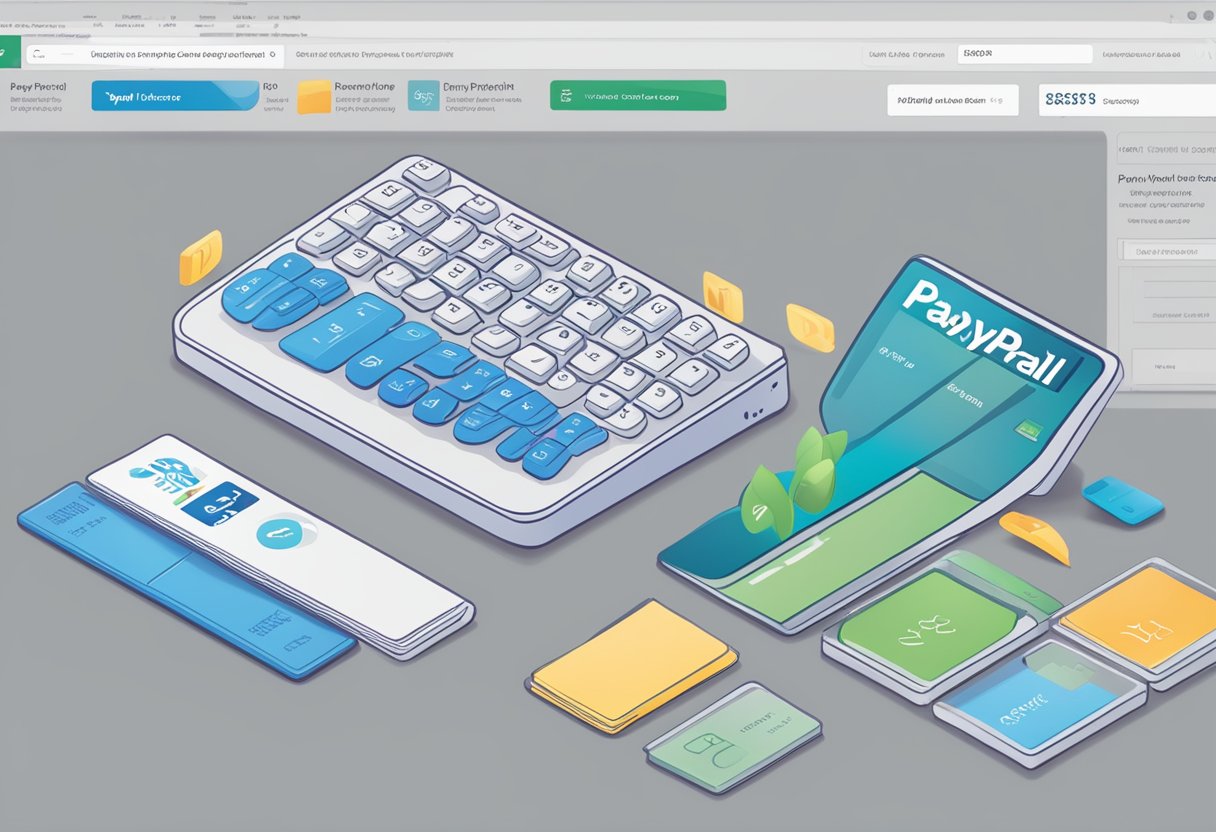PayPal Fees Calculator; PayPal has become one of the most popular online payment platforms in the world. With its ease of use, security, and convenience, it has become the go-to platform for many individuals and businesses. However, one thing that many people struggle with is understanding the fees associated with using PayPal. In 2024, PayPal’s fee structure has been updated, and it is important to understand these changes to avoid any surprises.

Understanding PayPal fees is essential for anyone who uses the platform. There are various types of fees associated with using PayPal, and these can vary depending on the type of transaction. For example, there are fees for personal use, fees for goods and services, fees for freelancers and businesses, and fees for nonprofits. It is important to understand the different types of fees and how they are calculated to avoid any unexpected charges.
Also you may like: PayPal Fees 2024: What You Need to Know
To help users calculate their PayPal fees accurately, there are several PayPal fees calculators available online. These calculators take into account the type of transaction, the amount of money being sent or received, and other factors to give users an accurate estimate of the fees they will be charged. By using a PayPal fees calculator, users can avoid any surprises and ensure that they are not overcharged.
Key Takeaways
- PayPal has updated its fee structure in 2024, and it is important to understand these changes to avoid any surprises.
- There are various types of fees associated with using PayPal, including fees for personal use, goods and services, freelancers and businesses, and nonprofits.
- To avoid any unexpected charges, users can use PayPal fees calculators to accurately calculate the fees they will be charged.
Understanding PayPal Fees
PayPal is a popular payment gateway that allows individuals and businesses to send and receive money online. However, PayPal charges fees for its services, which can vary depending on the type of transaction. Understanding PayPal fees is essential for anyone who uses the platform.
PayPal Fees for Domestic Transactions
For domestic transactions, PayPal charges a fee of 2.9% of the transaction amount plus $0.30 per transaction. This fee applies to transactions where the sender and receiver are both located in the United States.
PayPal Fees for International Transactions
For international transactions, PayPal charges a fee of 4.4% of the transaction amount plus a fixed fee based on the currency received. This fee can vary depending on the country of the sender and receiver.
PayPal Micropayments
PayPal also offers a micropayments feature for transactions under $10. For these transactions, PayPal charges a fee of 5% of the transaction amount plus $0.05 per transaction. This feature is useful for businesses that sell low-cost items.
Other Fees
In addition to transaction fees, PayPal may charge other fees, such as chargeback fees, currency conversion fees, and cross-border fees. It’s important to review PayPal’s fee schedule to understand all the potential fees.
Overall, understanding PayPal fees is crucial for anyone who uses the platform. By knowing the fees, individuals and businesses can make informed decisions about when and how to use PayPal for their transactions.
Types of PayPal Fees in 2024
PayPal charges various types of fees depending on the type of transaction. Here are the three main types of PayPal fees in 2024:
Commercial Transactions
For commercial transactions, PayPal charges a fee consisting of a percentage of the total transaction value plus a fixed rate tied to currency. The PayPal Checkout fee is 3.49% plus a fixed fee, while QR Code Transactions have a 2.29% fee plus a fixed amount. These fees apply when goods or services are sold, and the transaction occurs when both the sender and receiver are in the same country.
International Payments
For international payments, PayPal charges a fee consisting of a percentage of the total transaction value plus a fixed rate tied to currency. The PayPal Checkout fee for international payments is also 3.49% plus a fixed fee, while QR Code Transactions have a 4.99% fee plus a fixed amount. These fees apply when goods or services are sold, and the transaction occurs when the sender and receiver are in different countries.
Currency Conversion
If a payment involves currency conversion, PayPal charges an additional fee on top of the transaction fee. The currency conversion fee is calculated using the wholesale exchange rate, which is the rate at which PayPal obtains foreign currency. The currency conversion fee varies depending on the currency involved in the transaction, and it ranges from 2.5% to 4%.
It is important to note that these fees are subject to change, and PayPal may update its fees at any time. Therefore, it is advisable to use a PayPal fee calculator to determine the exact fees for a particular transaction.
PayPal Fees for Personal Use

When using PayPal for personal transactions, the fees charged depend on the payment method used and the location of the sender and recipient. PayPal charges a fee for receiving payments for goods and services and for sending money to friends and family. The fee charged for receiving payments for goods and services is usually 2.9% + $0.30 per transaction. The fee for sending money to friends and family is free if the payment is funded by a bank account, but if funded by a credit or debit card, a fee of 2.9% + $0.30 per transaction is charged.
PayPal also charges a currency conversion fee of 2.5% for transactions involving a currency conversion. This fee is applied to the exchange rate and is in addition to the transaction fee. The currency conversion fee is waived for transactions where the sender and recipient have the same currency.
It is important to note that PayPal may also charge additional fees for certain transactions, such as chargebacks and refunds. These fees vary depending on the circumstances of the transaction and can be found on the PayPal website.
Overall, PayPal fees for personal use are relatively straightforward and transparent. Users can easily calculate the fees using PayPal’s fee calculator or by referring to the fee schedule on the PayPal website. By understanding the fees associated with personal transactions, users can make informed decisions about how to use PayPal to send and receive money.
Calculating Fees for Goods and Services
When using PayPal to receive payments for goods and services, sellers are charged a fee based on the transaction amount. The fee varies depending on the country of the seller and the currency used for the transaction.
To calculate the fees for goods and services, sellers can use any of the PayPal fee calculators available online. These calculators are easy to use and provide accurate results.
For example, the Online Fee Calculator allows sellers to enter the transaction amount, select the country of the seller, and the currency used for the transaction. The calculator then displays the total fees charged by PayPal, including the fixed fee and the percentage fee.
Another option is the PayPal Goods and Services Fee Calculator, which provides the most up-to-date fees charged by PayPal. The calculator requires sellers to enter the transaction amount and the country of the seller. The calculator then displays the total fees charged by PayPal, including the fixed fee and the percentage fee.
It is important for sellers to keep in mind that the fees charged by PayPal are subject to change at any time. Therefore, it is recommended to use a fee calculator that is regularly updated to ensure accurate results.
In addition to the fees charged by PayPal, sellers should also consider other factors such as currency conversion fees and any additional fees charged by their bank. By taking these factors into account, sellers can accurately calculate the total cost of accepting payments through PayPal for goods and services.
PayPal Fee Structure for Freelancers and Businesses
PayPal is a popular payment platform that charges fees for its services. The fees vary depending on the type of transaction, currency, and location of the buyer and seller. Freelancers and businesses need to be aware of the fee structure to avoid any surprises and accurately calculate their profits.
Transaction Fees
PayPal charges a transaction fee for every payment received. The fee is a percentage of the total transaction value plus a fixed fee. The percentage varies depending on the country of the buyer and seller and the type of transaction. For example, in the United States, the fee for a domestic transaction is 2.9% plus $0.30 USD per transaction.
Currency Conversion Fees
If the buyer and seller have different currencies, PayPal charges a currency conversion fee. The fee is a percentage of the converted amount plus a fixed fee. The percentage varies depending on the country of the buyer and seller. For example, in the United States, the fee for a currency conversion is 3.0% of the converted amount.
Micropayments
For transactions under $10 USD, PayPal charges a lower percentage fee plus a fixed fee. The percentage varies depending on the country of the buyer and seller. For example, in the United States, the fee for a micropayment is 5.0% plus $0.05 USD per transaction.
Additional Fees
PayPal charges additional fees for certain services, such as chargebacks, refunds, and international payments. These fees vary depending on the country of the buyer and seller and the type of transaction.
In conclusion, freelancers and businesses using PayPal should be aware of the fee structure to accurately calculate their profits. The fees vary depending on the type of transaction, currency, and location of the buyer and seller. By understanding the fee structure, users can avoid any surprises and make informed decisions about their transactions.
Reducing PayPal Fees
PayPal is a popular payment gateway that is used by many individuals and businesses to send and receive payments online. However, PayPal charges fees for its services, which can add up over time. Fortunately, there are some ways to reduce PayPal fees.
1. Choose the Right Account Type
One way to reduce PayPal fees is by choosing the right account type. PayPal offers two types of accounts: Personal and Business. Personal accounts are designed for individuals who want to use PayPal to send and receive money online. Business accounts are designed for businesses that want to accept payments online.
Business accounts come with more features than personal accounts, including the ability to accept credit card payments and access to PayPal’s API. However, they also come with higher fees. If you are an individual who only uses PayPal occasionally, a personal account may be the best option for you.
2. Use PayPal’s Micropayments Plan
If you sell items online for less than $10, PayPal’s Micropayments plan may be a good option for you. This plan charges a lower fee for transactions under $10. The fee is 5% + $0.05 per transaction, compared to the standard fee of 2.9% + $0.30 per transaction.
3. Avoid Currency Conversion Fees
If you receive payments in a currency other than your own, PayPal will charge a currency conversion fee. This fee can be as high as 4% of the transaction amount. To avoid this fee, consider opening a bank account in the currency you receive payments in.
4. Use PayPal’s Fee Calculator
Finally, to avoid any surprises when it comes to PayPal fees, use PayPal’s fee calculator. This tool allows you to calculate the fees for any transaction before you send or receive money. By knowing the fees ahead of time, you can make informed decisions about how to send and receive payments.
By following these tips, you can reduce the fees you pay when using PayPal. Keep in mind that while these strategies can help reduce fees, they may not eliminate them entirely.
PayPal Fees for Nonprofits
Nonprofit organizations have a discounted fee structure with PayPal, making it an attractive payment processing option for charities and other nonprofit groups. PayPal nonprofit fees are 1.99% + $0.49 per domestic transaction, which is lower than the standard fee for businesses of 2.89% + $0.49 per transaction. However, it is important to note that PayPal charges an additional 1.50% for all international donations, and fixed fees vary by location.
Nonprofits can also take advantage of PayPal’s fundraising tools, such as the ability to create customizable donation pages and accept recurring donations. PayPal also offers a mobile card reader, PayPal Here, which allows nonprofits to accept credit card payments at events and other in-person settings.
It is important for nonprofits to carefully consider all of the fees associated with PayPal, including transaction fees, fixed fees, and any additional costs for international donations. Nonprofits should also compare PayPal’s fees to other payment processing options to ensure they are getting the best deal for their organization.
Overall, PayPal can be a great option for nonprofits looking for a reliable and flexible payment processing solution. With its discounted fees for nonprofits and fundraising tools, PayPal can help nonprofits streamline their donation process and increase their fundraising efforts.
Disputes and Chargeback Fees
PayPal charges fees for disputes and chargebacks. A dispute occurs when a customer files a complaint about a transaction on their PayPal account. PayPal charges a fee of $20 per dispute, which is non-refundable. If the dispute is resolved in favor of the seller, the fee is refunded. However, if the dispute is resolved in favor of the buyer, the fee is not refunded.
A chargeback occurs when a customer files a complaint with their credit card issuer. PayPal charges a fee of $20 per chargeback, which is non-refundable. If the chargeback is resolved in favor of the seller, the fee is refunded. However, if the chargeback is resolved in favor of the buyer, the fee is not refunded.
PayPal also charges a High Volume dispute resolution fee to each dispute reported after the 1.5% rate. The standard dispute resolution fees apply unless the dispute rate is 1.5% or more, and the seller has completed more than 100 sales transactions in the last three full months.
It is important to note that disputes and chargebacks can have a significant impact on a seller’s profit margins. On average, for every $1 disputed against a business, they can lose up to $2.8 in profit Chargeflow. Therefore, it is crucial for sellers to keep their dispute and chargeback rates as low as possible.
Updates to PayPal Fees in 2024
PayPal has updated its fees for 2024, and it is important to understand the changes to avoid any surprises. The new fees apply to all transactions processed on or after January 1, 2024. Here are some key updates to the PayPal fees:
Domestic Transactions
For domestic transactions, PayPal charges a fee of 2.99% plus $0.49 per transaction. This fee applies when the sender and receiver are both located in the same country. The fee is based on the total transaction value, including tax and shipping costs.
International Transactions
For international transactions, PayPal charges a fee of 3.49% plus $0.49 per transaction. This fee applies when the sender and receiver are located in different countries. The fee is based on the total transaction value, including tax and shipping costs.
Micropayments
For micropayments, PayPal charges a fee of 5% plus $0.05 per transaction. This fee applies to transactions of $10 or less. Micropayments are typically used for digital goods and services.
Chargebacks
If a customer disputes a transaction and files a chargeback, PayPal charges a fee of $20. This fee is refunded if the chargeback is resolved in the merchant’s favor.
Refunds
If a merchant issues a refund, PayPal will refund the transaction fee for the initial payment. However, the fixed fee of $0.49 is non-refundable.
It is important to note that these fees are subject to change at any time. Merchants should regularly review PayPal’s fee schedule to ensure they are aware of any updates.
Also read:
